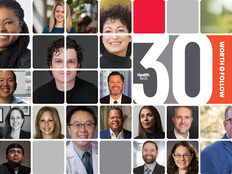Q&A: Jonathan Manis on IT Collaboration to Improve Patient Care
Improved care and a more satisfying patient experience depend heavily on integrated and unified communications. A host of IT technologies, from secure messaging to email to telehealth, enable clinicians to quickly share vital data and collaborate across a facility or across the country to deliver safer, better care while also redefining opportunities for physician-patient interaction.
What megatrends are driving more streamlined collaboration? What challenges do healthcare organizations face as they seek to better connect clinicians with each other and with their patients? How do you measure success?
We spoke to Sutter Health Senior Vice President and CIO Jonathan Manis about how his organization leverages IT collaboration and communication tools to more effectively and efficiently serve residents in more than 100 Northern California communities.
HEALTHTECH: What trends do you see driving the need for increased collaboration and communication?
MANIS: The megatrends center on convenience, access and affordability. At the macro-level, I certainly see a move to person centeredness, patient centeredness, individualized care and consumerism. Today’s mobile-connected public is looking for instant access and an immediacy of service. People are demanding anytime, anywhere, any mode or means of service or care. Also on that macro-level, social media is becoming ever more important and prominent. Our patients are going to Twitter, Yammer, Reddit and Angie’s List-like services and sharing their experiences. With the public collaborating and communicating as never before, we need to be doing the same thing to best serve their health and wellness needs.
At a lower level, there’s the emergence of accountable care organizations; a move from volume to value; large-scale insurance consolidations; and a real push toward interoperability, data sharing, the Internet of Things and cloud solutions. Also interesting is the increasing popularity and prominence of high-deductible health plan products.
On matters of their health and wellness, people now assume high quality and exceptional service. With more money coming directly out of their pockets for their care, provider organizations will be compelled to compete on cost. To lower costs, our industry must become far more efficient. To become more efficient, we must improve our ability to communicate, collaborate and coordinate our services.
HEALTHTECH: What collaboration and communication tools does Sutter Health offer for its clinicians?
MANIS: We have a Sutter wiki, which is an internal share site for physicians by physicians. They can share information, best practices and lessons learned, as well as append notes and collaborate. We also use Skype for Business, SharePoint, Yammer, Jabber, Vocera and other similar applications. We have multiple collaboration and communication tools in the Sutter portfolio.
Using these systems, we build what we call “communities of interest” around topics such as diabetes or Lyme disease. Physicians want to communicate and collaborate with each other, and scheduling a meeting or picking up the phone are not the only ways, or even the preferred ways, they want to connect with each other these days.
HEALTHTECH: Do you use cloud-based collaboration solutions?
MANIS: We are using the cloud more and more, both for traditional workforce support applications like Microsoft Office and also for those collaboration and communication tools I mentioned. In many cases, they’re already integrated into the available cloud solutions for workforce communication and support.
HEALTHTECH: What visual solution and communication displays does Sutter use for patients?
MANIS: We have wayfinding displays and scroll displays featuring everything from wait times and pharmacy order status to bedside education. We have video games and guest workstations to keep people entertained or productive if they should experience an unexpected wait. We have a pilot site where we provide iPads at the front door of the facility so that patients can check an order, find out where they need to go, get walking directions, make an appointment, share photos or email. And one of the benefits for us is that we know where the patient is located so we can optimize scheduling, queuing and patient flow.
HEALTHTECH: What role does telehealth play?
MANIS: Telehealth is a quickly growing segment of healthcare that’s all about convenience, access and affordability — the three things that will differentiate us in an increasingly competitive market. So far, it’s been very successful for us. We have been expanding rapidly, and utilization is far better than expected.
But we need to think differently about our model going forward. We need to stop thinking of it as something separate from or ancillary to our traditional care venues. Today we call it a “telehealth visit” or a “video visit.” We need to think of it as just another point of access or encounter. Again, the public is demanding access and convenience. When they need to see or speak with a care provider, they will expect an immediate connection on their own terms — in a physician’s office, in their home, online, at a hospital, in a clinic or at the touch of an icon on their smartphone from wherever they may be. That is what the future of care looks like. And it is coming very, very quickly.
HEALTHTECH: How do you safeguard the security of patient data when using these collaboration and communication tools?
MANIS: It’s the biggest challenge we currently face in our industry. We have a robust security and privacy program that includes encryption, data loss prevention, monitoring, detecting, training and education. But those who perpetrate cybercrimes and data theft — including foreign governments — are investing significantly in the tools and resources they need to breach defenses.
It is an ever-escalating threat environment, and addressing such threats consumes more and more of our industry’s limited resources. And we’re all trying to find the balance between collaborating and communicating for the care of a patient and our responsibility to safeguard and protect an individual’s privacy. There’s nothing more important to us.
HEALTHTECH: What benefits have you measured or observed for your clinicians and patients as a result of implementing collaboration and communication solutions?
MANIS: Anecdotally, we’re hearing of improvements in convenience, productivity and satisfaction for both patients and clinicians. Another benefit would be an elevation in the perception that we’re a technologically advanced organization. So everything is trending positive, but it’s still to be determined how that will play out long term in traditional value-measurement terms. I think it’s already “old school” to try to measure the value of EHRs [electronic health records], for example.
Hospitals simply can’t provide safe, high-quality healthcare without an EMR [electronic medical record] anymore. In traditional terms, how do we measure the value of communicating and collaborating for the benefit of a patient? We have to find ways to be more real-time in our feedback. People want to be connected, they want to be communicated with, they want to collaborate. That’s not up for debate — it’s just the way the world works. I think intuitively we all understand this is the right way to meet the needs of the people we exist to serve. These technologies offer us ways to increase our productivity as well as improve the quality of the care we provide.
HEALTHTECH: What collaboration and communications opportunities do you envision implementing in the future?
MANIS: I think the real opportunity is that we need to adopt some of the same technology and consumer-focused practices that have revolutionized the retail industry. What do patients and customers want? How do they want it? How can we make it immediately available to them? How can we provide immediate access to clinicians, physicians and care providers? What can we learn from more traditional consumer-centric industries?
It could be alerts, reminders, encouragement, tips, notifications, discounts, credits or perhaps a loyalty program. And we should even be able to offer valued recommendations based on historical patterns and preferences, much like Amazon provides. The tools we need to connect the dots and better serve the needs of our patients and the preferences of our customers already exist. They are just not pervasive in the healthcare industry.
HEALTHTECH: What advice would you offer your peers when it comes to collaboration and communication?
MANIS: We used to think of ourselves as a healthcare organization with advanced technology. We are beginning to realize that we are also an advanced technology company that provides healthcare. It’s important to listen to and learn from our customers and know how they connect in their personal lives, such as instant messaging, texting, Facebook, Twitter, Instagram and Snapchat. They expect and will soon demand to be connected to those who serve their healthcare needs using the same technologies.
If we don’t develop or implement ways to connect, collaborate and communicate with our patients and customers when, where and how they prefer, someone else will.








